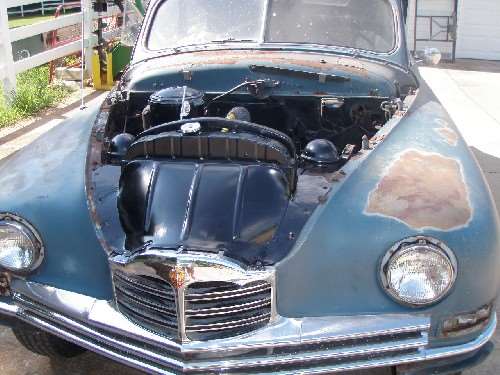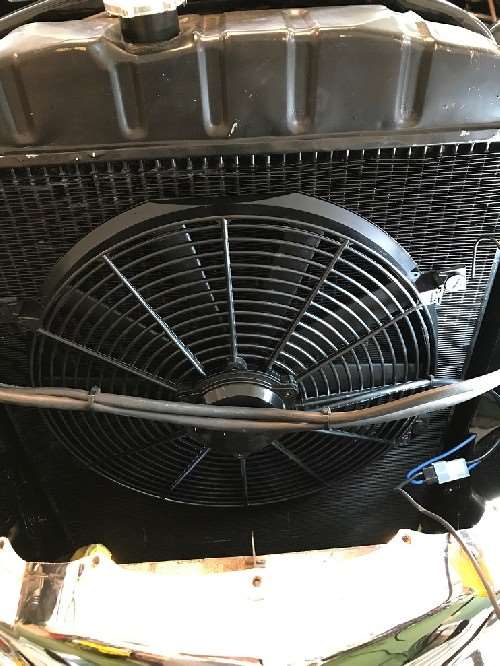|
Re: Change of radiator core affecting cooling performance in 1949, 23rd series
|
||||
|---|---|---|---|---|
|
Forum Ambassador
|
Since Packard offered what they called a heavy duty fan for situations where slow speed caused inadequate air flow and overheating (heavy duty appears to have been a slightly larger diameter fan on some engines and an extra blade on others) how about trying a modern high pitch 6 blade flex fan used for AC cars and see if that would increase airflow.
Some are already black and others have painted the blades black and managed to disguise it fairly well. That would be a lot cheaper than either a pusher fan or a new radiator.
Posted on: 2017/8/23 21:38
|
|||
|
Howard
|
||||
|
||||
|
Re: Change of radiator core affecting cooling performance in 1949, 23rd series
|
||||
|---|---|---|---|---|
|
Just can't stay away

|
That is a good idea. I was thinking of a flex fan. Where do you think I could get one (in black)?
Posted on: 2017/8/23 21:43
|
|||
|
||||
|
Re: Change of radiator core affecting cooling performance in 1949, 23rd series
|
||||
|---|---|---|---|---|
|
Forum Ambassador
|
Hopefully someone will come along that has already done it for your model and has a number but if not:
Summit Racing has a considerable selection of fans in various sizes and material. You will have to do some homework and measure your fan and space to find the largest that will fit. Do a search for "fans" and select "mechanical" on their site and when the 150 or so populate the page drill down thru the option menus to narrow the choices. I see about 50 in black only and many others with black hubs but bright aluminum blades. The issue on our cars may be the center hole pilot diameter and finding a spacer. The universal fans all have elongated slots for the 4 mounting bolts so that part is generally not an issue. The center pilot holes on the fans are modern sizes but Packard used a large diameter and that is more the problem. Some have not used a spacer but rather positioned the fan out over the large pilot with washers and only rely on the mounting bolts. I personally do not like that practice and for safety strongly recommend a spacer. I don't know what size the pilot is on your car as there were different diameters over the years on the various engines. The spacer needs to have a hole for the existing diameter on one side and convert to the modern (usually 5/8") pilot on the other. If you go to a larger diameter fan it may also need to be thick enough to move the blade out so the blade tips clear the vibration damper yet not so thick that it gets too close to the radiator. I needed to move the fan out on a 356 engine so the fan would clear the AC belt. That engine uses an odd larger diameter pilot than the smaller engines. I couldn't find a spacer with a large enough hole so had to make my own.
Posted on: 2017/8/23 22:30
|
|||
|
Howard
|
||||
|
||||
|
Re: Change of radiator core affecting cooling performance in 1949, 23rd series
|
||||
|---|---|---|---|---|
|
Home away from home
|
I had successful results using an after market 6-blade flex fan on a 55 Clipper Super. What Howard says about the water pump shaft diameter is true, and none of the modern fans have this diameter pilot hole. I used spacers under the four bolts to mount the fan so the pilot hole would clear the pump shaft. The bolt slots in the fan are at a diagonal in order to accommodate a variety of bolt patterns. Because of the diagonal shape they are self-centering. The fan was secure and true in my installation.
Packard 5-blade heavy duty fans are often for sale on eBay and in the For Sale sections of auto related websites, including this one. One of these fans would be desired over an after market flex type. I had the radiator on my 47 Clipper Custom re-cored with a 4-row staggered tube type. I had good results with the re-cored radiator. JWL
Posted on: 2017/8/24 11:02
|
|||
|
We move toward
And make happen What occupies our mind... (W. Scherer) |
||||
|
||||
|
Re: Change of radiator core affecting cooling performance in 1949, 23rd series
|
||||
|---|---|---|---|---|
|
Home away from home
|
In your external fan picture, the front shroud must have been taken off. Do you use it when it's not fan assisted or is it missing? It directs the flow to the radiator from below. It's the ribbed pan shown in this photo.
Posted on: 2017/8/27 20:24
|
|||
|
||||
|
Re: Change of radiator core affecting cooling performance in 1949, 23rd series
|
||||
|---|---|---|---|---|
|
Just can't stay away

|
I normally have the shroud installed. I only removed it to do the test.
Since then I have installed a pusher fan which operates on 6 volts and is controlled by a user installed toggle switch under the dash board. This helps a lot. But the bigger point is that regardless of pusher fans and flex fans, the car should cool normally if restored to 1949 specifications, which I have done for the most part. I still believe that the larger radiator is now having to be compensated for by pushing more air through it. And if the radiator shop had used the right core with the correct fins per inch and number of columns, I would not have to be doing all this jury rigging. I hope to have more to come in the future on this.
Posted on: 2017/8/28 7:19
|
|||
|
||||
|
Re: Change of radiator core affecting cooling performance in 1949, 23rd series
|
||||
|---|---|---|---|---|
|
Home away from home
|
I may have missed it, but what sort of temp differential were you getting between top and bottom before installing the pusher? After?
My take on the issue is that the gap between impeller and pump body is too large. I like mine down around .020". The effect of a larger gap will be more noticeable at low speeds.
Posted on: 2017/8/28 12:44
|
|||
|
||||
|
Re: Change of radiator core affecting cooling performance in 1949, 23rd series
|
||||
|---|---|---|---|---|
|
Just can't stay away

|
Ross,
I had about a 10 degree drop across the radiator from top to bottom before installing the pusher fan. I have not measured it since so let me get a new measurement for you for before and after and I will report back. Thanks
Posted on: 2017/8/28 19:12
|
|||
|
||||
|
Re: Change of radiator core affecting cooling performance in 1949, 23rd series
|
||||
|---|---|---|---|---|
|
Just can't stay away

|
Ross,
I was able to measure the temperature delta across the radiator today as follows: Ambient temperature outside at the time of the test was 79 degrees After driving around town, the engine was around 178 degrees at the front of engine with the car moving. Once I pulled in the driveway, I turned on the pusher fan to see if the engine temperature could be held at the 178 degrees or see if the temperature would creep up. After sitting for about 15 minutes with Pusher fan on: Top of radiator is 189 degrees Bottom of radiator is 178 degrees Engine front is 194 degrees Engine rear is 207 degrees So the engine temperature crept up around 16 degrees at idle with the pusher fan on (based on engine front measurements) I would think that with the pusher fan on at idle the engine temperature should maintain about the same as cruising (when the pusher fan is off). Does that sound correct? Instead I found that the temperature still crept up at idle. This was done with the hood open. Once I closed the hood, everything went up around another 5 degrees. Does 11 degrees drop across the radiator sound right from top to bottom? I have read that it should be closer to 20 degrees. I did not do the test with the pusher fan off at idle since my experience is that the engine would only get hotter and I don't think I want to chance it getting too hot since I just had the engine rebuilt. I would appreciate your comments. Thank you
Posted on: 2017/9/4 16:50
|
|||
|
||||

 (175.07 KB)
(175.07 KB)








